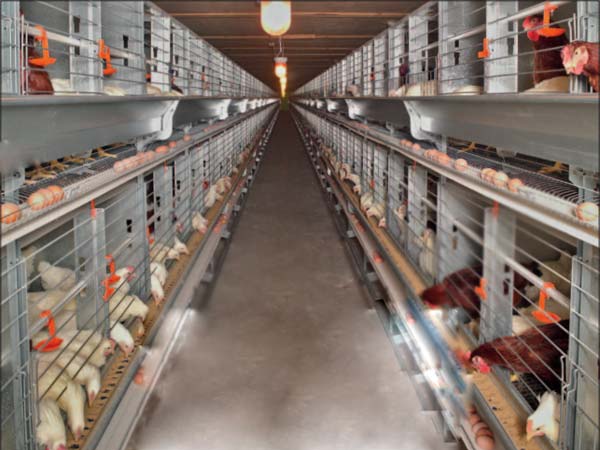The optimal environmental temperature for laying hens is 15℃ ~ 25℃, and the production performance is the best in this temperature range. However, since the beginning of summer, due to heat stress, mosquito bites and other factors, the feed intake has decreased, which has a great impact on the egg laying rate. Therefore, when raising laying hens in summer, in order to ensure high and stable production of laying hens, the following is the key.
The first is to reduce the temperature of the chicken battery cages . The temperature at noon in summer is relatively high, especially when the chicken is in the coop, the activity intensity is relatively small. When the temperature exceeds 32℃, the chicken flock is easy to suffer heatstroke. Therefore, effective prevention and control measures should be taken in time. First, ventilation and cooling work should be done to prevent the occurrence of heat stress in the chicken. Ventilate and cool down. Open windows and doors as much as possible to speed up the air circulation in the chicken coop. If necessary, install ventilation fans on the top or doors and windows of the chicken coop to increase the air convection between the chicken coop and the outside world and reduce the temperature of the chicken coop. However, it is necessary to avoid direct sunlight from windows, doors and ventilation holes to the chickens. It is better to plant trees and green around the chicken coops to ensure the freshness and freshness of the air.
Sprinkle cold water on the top of the hen house every hot noon to reduce the temperature of the hen house. Under the condition of poor natural ventilation, water spray is used to cool the chicken body and the chicken coop directly at noon and afternoon every day, and water spray is used to absorb the heat of the chicken coop. The water curtain can be made at the door and window of the chicken coop when conditions permit, and air can enter the chicken coop through the water curtain to lower the temperature inside the chicken coop by 5℃ ~ 6℃.

Due to the high temperature in summer, the intake of chickens decreases. In order to maintain high and stable production of laying hens, the concentration of feed must be changed to meet the normal physiological needs of laying hens and the nutritional needs of production. During the high temperature season of energy feed, the feed intake of laying hens is lower than usual. Therefore, the consumption of grain energy feed should be adjusted and 0.5% ~ 1.5% oil should be added appropriately to improve the energy intake and utilization rate. Increasing the hot summer days of protein feed will reduce the feed intake of chickens. Only by increasing the protein level in the feed and ensuring the amino acid balance can the demand for protein in the breeding equipment be met, and the egg laying rate will not be affected due to insufficient protein caused by reduced feed intake.
Due to the high temperature in summer, chickens drink a lot of water, resulting in thin feces, which ferment quickly in the chicken house, producing a large amount of heat and toxic gases such as hydrogen sulfide and ammonia. In addition, the abundance of mosquitoes and flies can also bite chickens and spread epidemics. Therefore, it is also very important to do a good job in environmental sanitation and poultry farming cage equipment. Clean the water line of chicken coop regularly.
Any breeding factory is of vital importance to the prevention and control of epidemic diseases in any season. Only by controlling the occurrence of epidemic diseases and ensuring the health of chickens can the high and stable yield of chickens be guaranteed. In summer, the temperature is high and the chicken is weak. Therefore, adjusting the chicken's constitution to the best health state before the high temperature season is the prerequisite for safe and stable hot summer.
